Home | Front Page | Index | Blog | New | Contact | Site Map
Paris 1999
Paris 2005
Paris 2007
France 2007
Paris 2008
France 2008

Travel 2007
Sydney
South Africa
Paris
Darlington
Click on photos to get full-size images in a separate browser window.
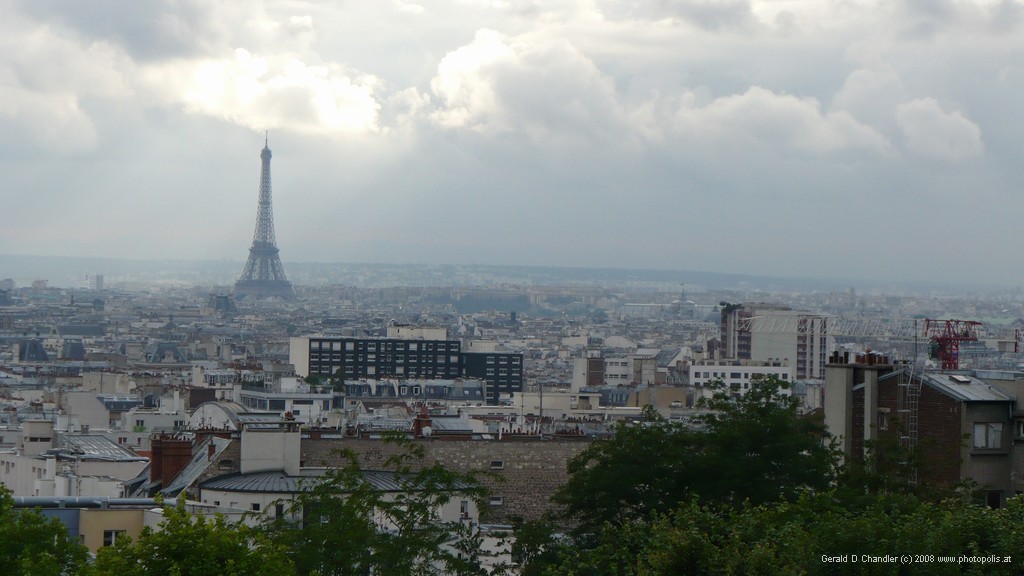
Central Paris seen from Parc de Belleville |
Third time 'round lucky? Hardly! Not that we weren't lucky to be in Paris for the third time, but that we'd also been lucky times one and two We've told the story so many times that we aren't sure when and to whom, so here it is again: While in Sydney we couldn't make up our mind which way to jump when we got an offer from Veronica: come take my Belleville place while I walk north from Portugal to France. We said yes, bought round-the-world tickets, and ended up in Paris for three months. One among the many reasons we were happy to be there was the upcoming French presidential elections. Political Junkie heaven.
Our arrival was eased by a gift from Ann Spadafora: luxury transport in a private van from CDG airport. We're used to dragging our own bags and making our way by public transport, but we can hardly say we regretted this gift. Veronica wasn't there to greet us but had made convenient arrangments for key pickup and we were very soon ensconced in her apartment and at liberty to explore the changes she had made: new windows made a quiet place even quieter and there was no trace in the bathroom of the old leak from upstairs. Whereas in 2005 we had had to work hard to get broadband access it was right there waiting for us. We did go out and buy a wifi router so that we could both be on line, but that wasn't either difficult or costly.
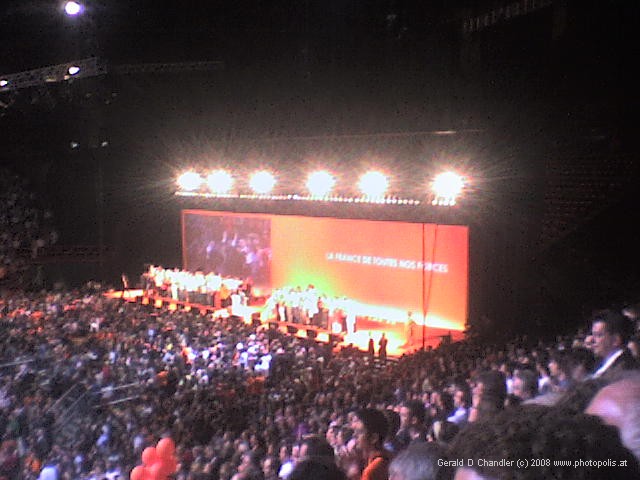
Nicolas Sarkozy Campaign Rally at Bercy OmniSport |
To outsiders (and perhaps to the French) the way voting works for French presidential elections surely seems strange. It was set up by Charles de Gaulle (and his advisors) and seemed perfectly logical to them. But, as with so many logical things, it doesn't quite work as intended. There are two rounds of voting, with the two highest scoring candidates going on to the second and final round. An unintended consequence is that many minor candidates are seriously present in the first round. The vote they get determines the size of the subsidy they get for the next election, so they really try hard. And, because TV is essentially free for them during this period, the minor candidates play the system for all the publicity they can.
Those on the far left who expect to lose also expect in the final round to support the main left candidate, that of the Socialist Party. The same is true for those on the right, although the fragmentation is smaller there. In the last election, in 2002, things took an unexpected twist: the left-vote was so split that Jean Marie Le Pen, head of the Front National, a far right party, beat out (but just barely, it is true) the Socialist and was promoted to the final against Jacques Chirac. This year every party, especially those on the left, wanted to make sure there was no repeat of 2002.
We arrived on April 17, ten days before voting for Round One, and just over three weeks before the final May 6 vote. This, we were happy to learn, was early enough to attend a rally for every major candidate and to listen to hour upon hour of French political discourse by major and minor candidates and their interviewers and their critics. Our first event starred Nicolas Sarkozy and was held at the Omnisport indoor stadium in the Bercy district. It was filled to overflowing, all 16,000+ seats taken; and we were lucky to get two of them. We went with our friend François, planning to meet his friend Sylvie there. The hall was so noisy that although both have cell phones they couldn't communicate by voice. When we tried text messaging we couldn't make it clear in what seat and row we were to be found. Sarkozy, as should be expected, wowed the very partisan crowd.
A few days later we were back at Bercy, this time with about 17,000 screaming supporters of François Bayrou, head of the Centrist UDF (Union pour la démocratie française). Don't take it too seriously when people complain that elections in the USA are all about personality. Bayrou's event, and before him Sarkozy's, and after them, Royal, was all about the speakers. Yes, they discussed policies, and yes, there were differences. But in the end it would be a matter of trust: who could you believe and who would carry out the enunciated policies.
Just a few days after the Bercy meeting the first round of voting was held and, as expected, Sarkozy came in first. As hoped by the Left, heart-in-hand, Ségolène Royal, the socialist candidate came in second. There wasn't a repeat of the 2002 split. While Le Pen failed to reach the second round we got to hear him in person because he traditionally holds a big rally at Place de l'Opéra on May 1. Having in a previous visit to Paris watched and marched with the leftist (read: communist, anti-USA, labor, and some socialist) parade we went to see Le Pen. What a contrast, being almost at his feet amongst a crowd of supporters that at most numbered 2,000 rather than in the overwhelming crowd that kept us so far away from Sarkozy and Bayrou that only the big electronic screen behind let us know what was going on.
On the same day, May 1, that we heard Le Pen at noon we went to a late afternoon rally for Ségolène Royal. Did Sarkozy fill Bercy? Then Royal was determined to fill Charlety, an open-air stadium about 50% bigger. The "éléphants" (big wigs) of the Socialist party and numerous of her advisors warned against it, but as in so many other aspects of the campaign, Ségolène didn't listen to them. And she turned out to be right. The stadium (normally used for soccer matches and with a special link to the events of May, 1968) was so packed that we couldn't get normal seats. We sat on one of the flights of concrete steps that separate each section, on the opposite side of the stadium from where she made her appearance. As we waited an hour and then another hour (how long it seemed!) we heard various singers, almost all unknown to us, singing lyrics either unknown, or unpleasant. But we can say we did it: heard all of the major candidates in person.

Gerry Waiting |
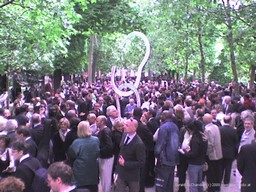
The Crowd: Where's Sarko? |
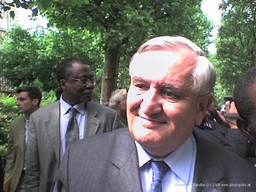
Former PM Raffarin |
Nicolas Sarkozy has a well-earned reputation for being hyperactive and that worked to our benefit. About a week after he was elected (but before he officially became president) a statue was unveiled in the Jardin du Luxembourg to commemorate the end of French slavery and the slave trade. Future president Sarkozy and current president Chirac were there as well as half a dozen top French officials. So were we. (We'd gone out to eat our lunch in the park and see more of Paris.) Gerry made his way to the front of the barrier that separated the crowd of about 500 onlookers from the officials and participants. For his effort he got to shake the hand of Chirac and have Sarkozy shake his hand (Nicolas really grabs and gives a go).

Velib Stand |

When can I ride? |
Throughout our stay in Paris we watched the new system of Véloparis being installed and always felt a bit — more than a bit — jealous that we wouldn't get to use it. A month after our arrival in Sydney we'd managed to buy bicycles and had enjoyed every day that our hearts pounded as we struggled up Sydney's slopes. It was with great reluctance that we sold the bikes as we left Sydney for South Africa. But it had to be. Then when we got to Paris we continually debated buying bikes; after all, Paris was bicycle-friendly and getting more so, with its multiple bike lanes and traffic-free Sundays. But our lives, or our apartment wasn't so bicycle-friendly, and the bike-shops weren't so pocket-book friendly. So we delayed and delayed and did nothing, because we had monthly transit cards and plenty to do.
As the weeks went by we saw the first signs of Véloparis and then read about it and thought it the answer to our dreams: Every 300 meters or so bicycle rental locations were to be installed in Paris. We delighted to see one being located opposite our nearby library with about15 bikes; the biggest that we saw must have had 30 bikes. The installation consisted of low docking stations to which the bikes were attached. By swiping a magnetic card one could release a bike and use it for a half-hour. Of course one had to be registered and pay an annual fee, but that, about 30 euros, seemed like nothing to us. As we write there is a strike of public transit in Paris and we imagine that all of the bikes are continually in use.
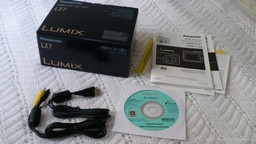
Lumix and Accessories |
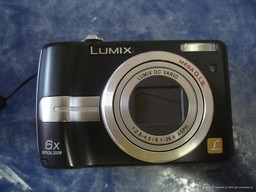
Lumix LZ7 with Venus III engine |
"What goes around comes around" comes to mind as we try to describe Gerry's travails with his camera. The phrase is entirely inappropriate except that in 1999 Gerry lost a camera in Paris and in 2007 bought one. It was his fifth camera of the year. It sort of made him whole again. Let's go back to the beginning, or at least 12 months earlier. In May, 2006, while traveling in Turkey, Gerry stepped backwards and fell off a curb. He was hurt and recovered. His long-time Sony video+still camera didn't. So in Basra he bought a new pocket-sized Sony still camera that doubled his pixels from 3 million to 6 and gave him a tapeless way of taking video. Overall, a pretty good little camera, bought at 1/6 the price he'd paid for the crashed Sony.
But it didn't last. While getting into a boat at Phuket, Thailand, the boat took a dip and so did Gerry and camera. Equation: camera + salt water = ruin. On to Kuala Lumpur and indecision and no new camera. And on to Singapore and the finding of a brand-new Panasonic model, the FZ50. As the Governor of New Jersey used to say about NJ, "You (the camera) and me (Gerry), perfect together." It was truly the best camera Gerry had every had. Near the end of our stay in South Africa Gerry climbed onto our rented car to get a better view. That was foolish (which Jan knew in advance) as Gerry fell and nearly lost his toe (it recovered) and did lose his camera (it didn't). As a stop-gap he switched to camera four, his VGA-quality cellphone camera.
In Paris he took the FZ50 to the Panasonic authorized service center and got an estimate: Repairs would cost (we're not kidding) 1034 euros. Price of a new camera? 450 euros. Disappointed, Gerry decided to continue to make do with the W300i phone camera until we got to New York where the same Panasonic FZ50 camera was 300 euros. But finally, at the end of May, he found a compact Panasonic with the same electronics as his beloved FZ50, but a much smaller body and lens. What it lost in zoom power was made up by the ease of carrying it. It takes wonderful pictures and (best of all?) he hasn't trashed it yet.
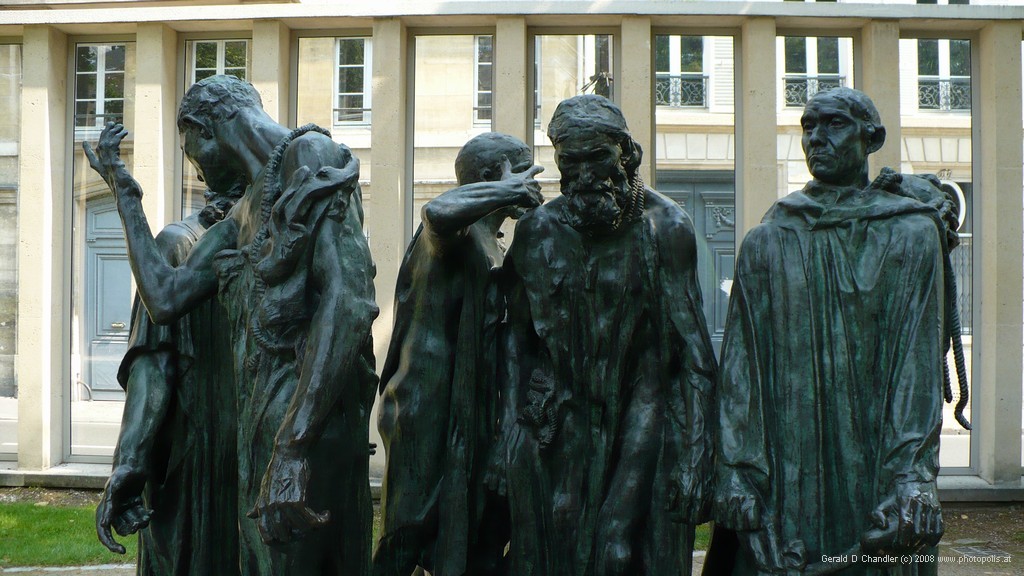
Rodin's Les Bourgeois de Calais |

Monumental Bourdelle Statues |
How can you visit Paris and not go to a museum? Maybe you can miss them, but you have to try hard. This time around we made our first visit to the Musée Rodin in several decades. It was much changed, we thought. The gardens had a greater presence in our minds and the house seemed more stuffed. (Maybe it is our brains that are stuffed and we used to be able to absorb more?) Whether our memory is right or wrong, the place is tremendous and we had a lovely time.
On the map we had found the Musée Bourdelle and decided on a visit; we'd never heard of this sculptor and wanted to expand our horizons. On our first attempt the museum was closed; on our second there was a semi-strike. Our third and successful attempt was greatly rewarding. We got in and found a worthy competitor to Rodin. In fact, in Bourdelle's life he was considered the great successor to Rodin, even if today he is comparatively forgotten.
A quick list is all we'll present about another half-dozen museums that were new to us and well worth the trip: Musée de La Vie Romantique, the medical museum in the Hôpital Val de Grace, the Chapelle Expiatoire in memory of Louis XVI and Marie-Antoinette, and the Shoah Memorial. We went to all of these after Gerry got his new camera and he has good pictures of them. Before the new camera we went to the Musée Zadkine and the old Bibliothèque Nationale. We even managed to see two museums in one night: on the "Nuit des Musées" when all of Paris' museums stay open to midnight or later and are free entry, we first went to the new Ethonological museum, Musée du Quai Branley, and followed that by crossing the river to the museum of modern art, Musée du Palais de Tokyo. We also made return trips to the Louvre, concentrating on the Sculpture Courts and the Louis Napoleon apartments; to the Musée Guimet and Musée Cernuschi, the Big Daddy and Little Rose of Buddhist art; and the Cimetière Monmartre, which too has interesting sculpture.
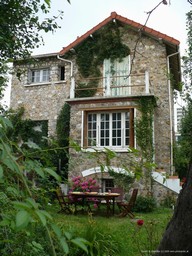
Franconville home |
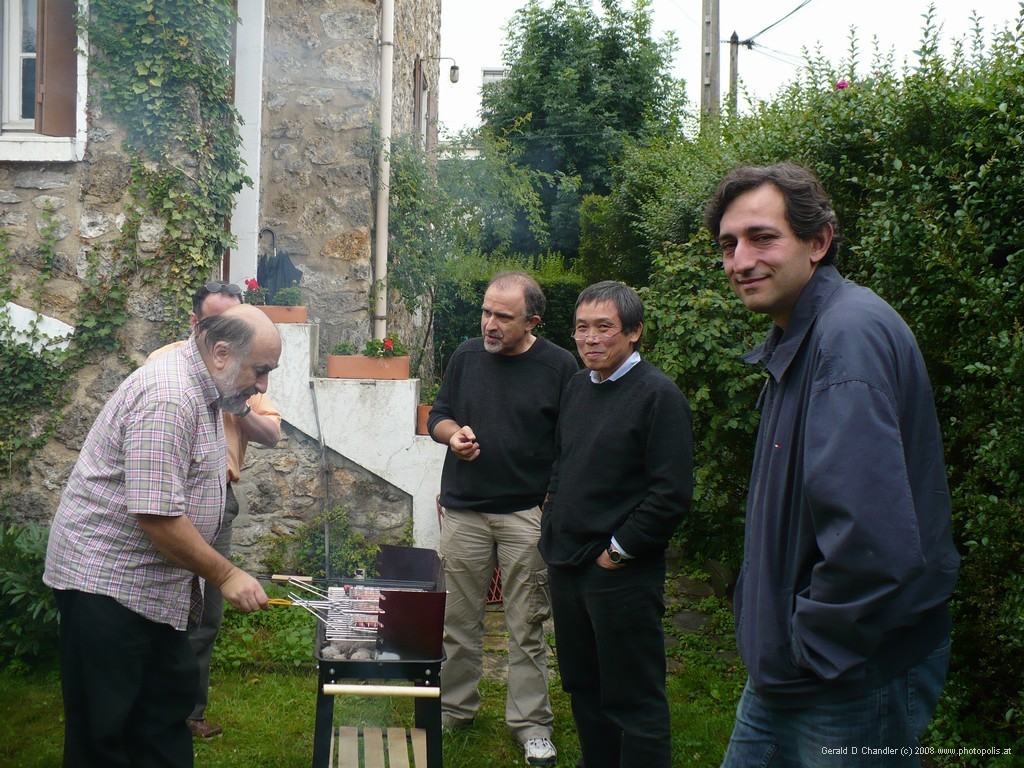
Barbeque Guests |
While in Paris we renewed old acquaintances and made some new ones. We caught up with François Armingaud, whom we hadn't seen in five years, and met his new companion, Sylvie. He has an annual garden party at his home in Franconville, in the near suburbs of Paris. We missed that one because we went to Pascale and Bertrand's wedding, but it was our good fortune that he had a second, late summer party. Among the interesting people we met was one fellow who created and runs an online dating service. Later we looked at his site and thought it great. Being in the computer industry it was interesting to hear how hard it was to make a profit, although it seemed that that hurdle was finally being crossed. At the party it rained on and off but that didn't dampen spirits at all. There was too much good food and plenty of chatter. It all ended very agreeably with a round of singing old pop songs.
We always see the Rémy's in Paris. This time we went to the threatre with them, making our first visit to an old classic, very popular in the 1890s, the Théâtre de la Porte St Martin, close to the Place de la République. Beforehand they introduced us to a tiny arcade the distracted passerby would never notice and certainly not suspect that it was filled with little "sidewalk" cafés. We ate very agreeably at an Indian one. The play was "L'Avare" (The Miser) by Molière. The good news is that the least skilled in French among us, Gerry, could follow most of it. What he couldn't follow the others had trouble with too because, being in character, the enunciation of the actors was often bad. The bad news is that the play is very dated and hardly seems plausible to us moderns.
To our pleased surprise we got to see the Ellis's in Paris. Anna and Steve were classmates of Jan's at Bradford. After graduation they both went to Brussells and got jobs with the European Commission. We hadn't seen them for many a year. Steve is now in charge of organizing major EU summits. A few days after they returned home it was quite a thrill to see Steve in the background of a TV news shot that featured German Chancellor Angela Merkel in the foreground at a summit.
Another old friend we saw wasn't even from Paris, although he has lived in France and is consequently fluent in French. Joe Nacmias we know from New York; he's an accountant and makes a major trip to Paris every spring to see his franco-American clients. So we caught up with him and his companion and made our first trip to Les Puces des Paris (the Flea market) in literally half a lifetime.
Coming home one day on a bus, chosen because it gave additional time to see and breathe in Paris (as compared to the Metro) we found ourselves seated next to the Heffelfingers. Hearing us speaking English they said hello; they were Americans from Atlanta making their first big trip to Europe. Katie would be presenting a paper in Vienna on some religious research she had done and was sandwiching that between visits to Paris, Rome, etc. We invited them over for snacks and got to know lots of what they were up to. Subsequently it was very interesting to be on their mailing list and read about their impressions.
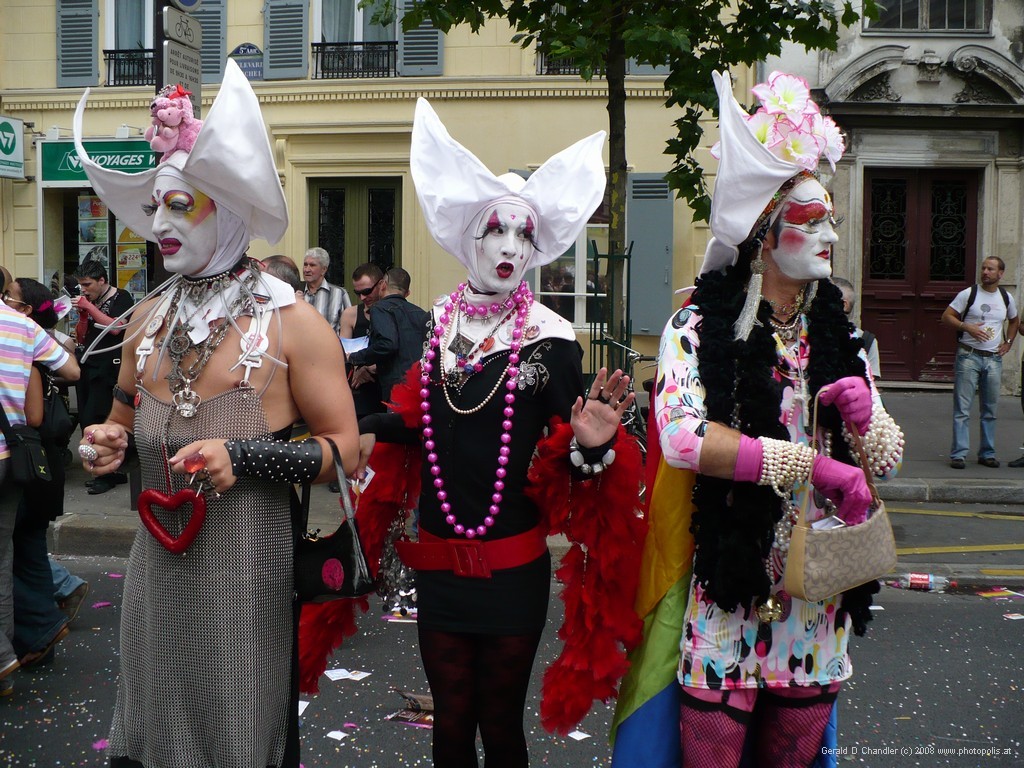
Gay Parade |
One day we went out to see what "the other half(?!)" looked like. Most of those in the Gay Parade were pretty tame (as it was two years earlier when we saw the Berlin Gay parade) but a few were noteworthy.
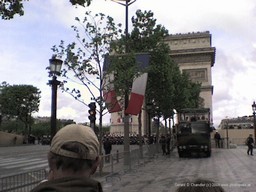
Our distant views of the WWII ceremonies
|
We also went to two more traditional public events. Both were on the Champs Elysées, both drew approximately the same cast, and both drew enormous crowds. The first was the ceremony to celebrate the end of World War II. The new and old Presidents of the République laid wreaths under the Arc de Triomphe. We were a few hundred meters down the avenue and could just barely see what was going on. The second was the celebration of the French Revolution ("Bastille Day" in English). This is a big military parade that starts at the Arc de Triomphe and ends at the Place de la Concorde, about two kilometers away. This year new President Sarkozy changed things a bit: he invited miltary delgations from all EU countries. And, to our misfortune, he shortened the parade for bigwigs, so that where they started they did not pass our spot. We did get to see all the traditional participants: the students from the military colleges, the city Firemen, and so forth.
And what did we look like in Paris? Take a look at us below. These were taken just two days before leaving Paris. What do others say of us?

Jan |

Gerry |